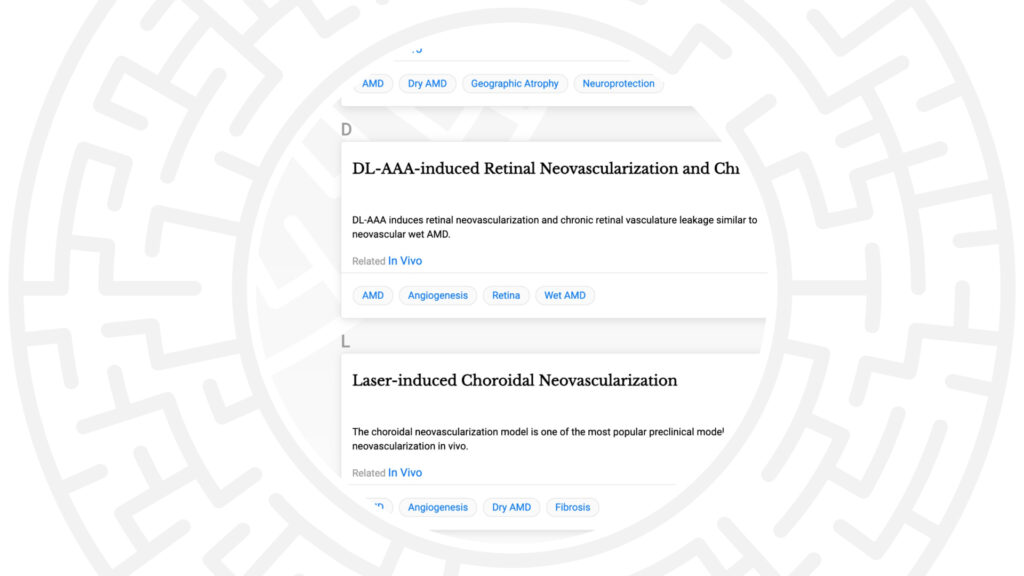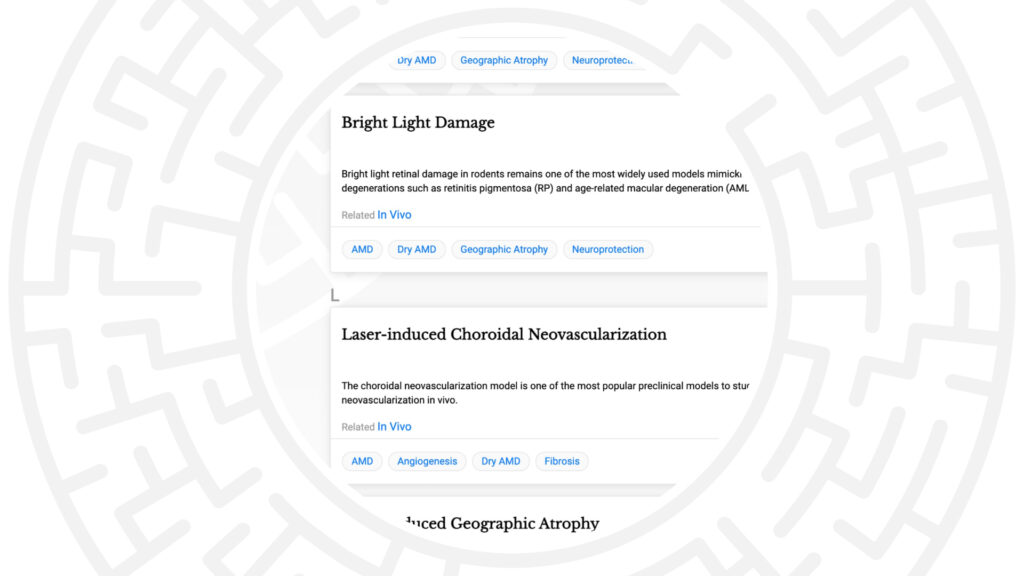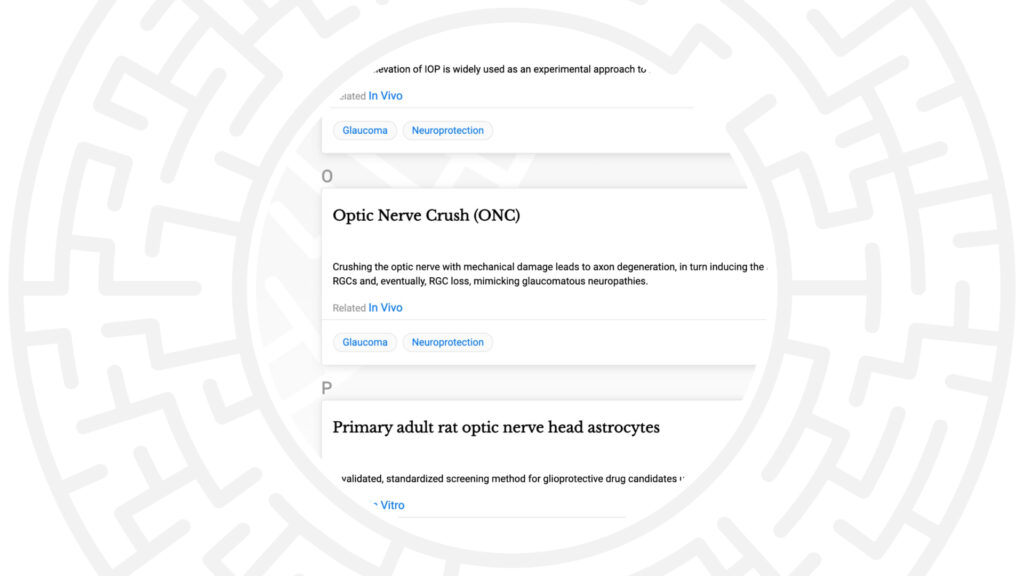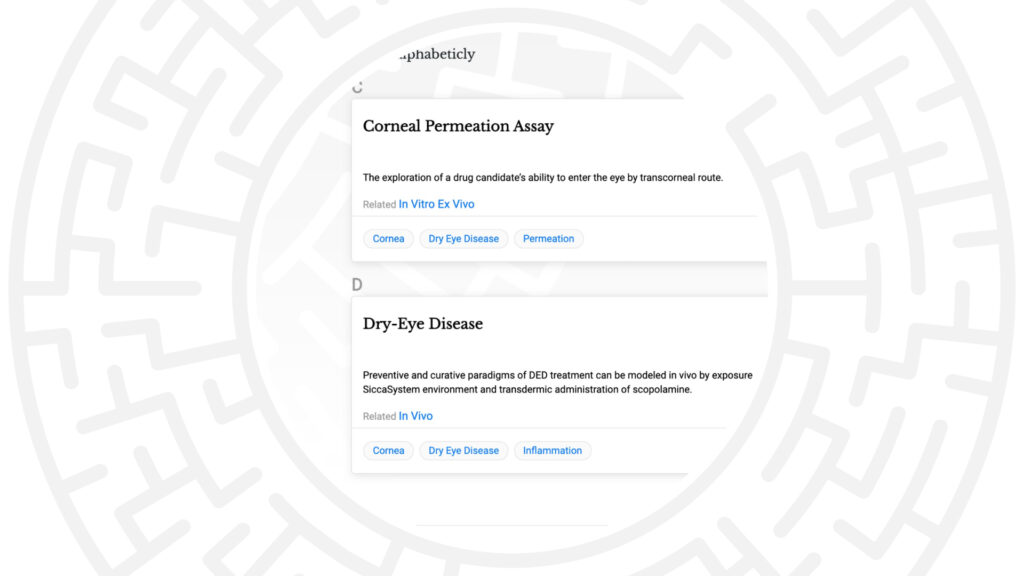Summary: This year again the work of Experimentica's scientists at the forefront of Ophthalmology research will be featured at the 2022 ARVO Annual Meeting.
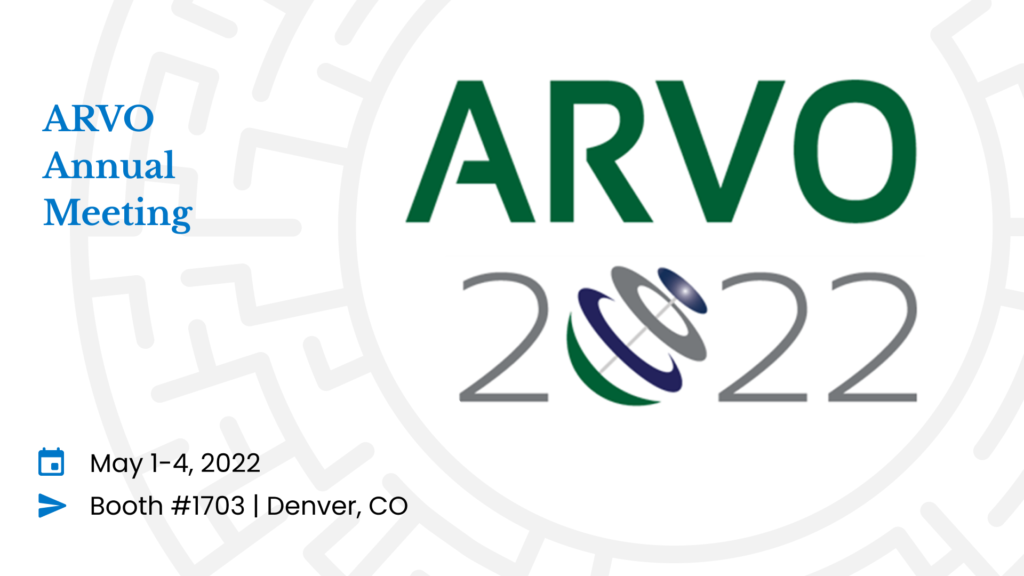
Content
ARVO advances research worldwide into understanding the visual system and preventing, treating and curing its disorders. This year again the work of Experimentica’s scientists at the forefront of Ophthalmology research will be featured at the 2022 ARVO Annual Meeting.
Follow our Scientists and visit us at booth #1703!
Presented by Experimentica Ltd.
Do not miss out on our team’s abstracts in physiopathology and preclinical model development.
A B S T R A C T
Novel rabbit model for particulate matter-induced allergic conjunctivitis.
5:15 PM – 7:15 PM MDT on Sunday, May 1 | A0433
Authors: Bacellar-Galdino M, Ghosh AK, Pappenhagen N, Iqbal S, Kaja S
Purpose: Particulate matter (PM) is a primary trigger for the development of acute and chronic ocular surface disease, including allergic conjunctivitis. The purpose of the present study was to develop a novel rabbit model for PM-induced allergic conjunctivitis to facilitate future targeted drug discovery and development.
A B S T R A C T
Manganese porphyrin antioxidant alleviates particulate matter-induced allergic conjunctivitis.
5:15 PM – 7:15 PM MDT on Sunday, May 1 | A0423
Authors: Ghosh AK, Iqbal S, Bacellar-Galdino M, Pappenhagen N, Nathaniel E, Kaja S
Purpose: Particulate matter (PM) is a well-known trigger for the development of both acute and chronic forms of ocular surface disease. The purpose of this study was to evaluate the prototypic manganese porphyrin, manganese(III) tetrakis(1-methyl-4-pyridyl) porphyrin (Mn-TM-2-PyP), for its ability to protect against PM-induced damage.
A B S T R A C T
Agonism of the liver X receptor improves dry eye pathology in vitro and in vivo.
2:00 PM – 4:00 PM MDT on Monday, May 2 | A0328
Authors: Ogle S, Kaja S, Jones W, Ghosh AK
Purpose: To evaluate pharmacologic liver X receptor agonism in human corneal epithelial cells and in a murine model for dry eye disease.
A B S T R A C T
Novel murine model for autoantibody-induced dry eye disease.
11:38 AM – 11:55 AM MDT on Tuesday, May 3 | 2A/3A Mile High Blrm
Authors: Kaja S, Bacellar-Galdino M, Mun C, Ghosh AK, Jain S
Purpose: Our previous studies have demonstrated the presence of anti-citrullinated protein autoantibodies (ACPA) in ocular surface washes from patients with autoimmune dry eye disease (DED). Moreover, this pathology was responsive to ocular surface immunoglobulin G (OSIG) treatment. The purpose of this study was to develop a murine model of autoantibody-induced DED to support future mechanistic and pharmacological studies.
A B S T R A C T
Comparison of the laser-induced choroidal neovascularization model pathology in C57BL/6J mice from different vendors.
1:00 PM – 3:00 PM MDT on Tuesday, May 3 | F0403
Authors: Vähätupa M, Kalesnykas G, Jokinen V, Nevalainen T, Tähtivaara L, Thapa R, Koskenniemi H, Tenhunen A, Lappeteläinen B, Haapaniemi AM, Kvietkauskiene N, Jarutis J, Bijeikis S, Kaja S, Cerrada-Gimenez M
Purpose: The mouse laser-induced choroidal neovascularization (CNV) model is the most popular experimental model to mimic the wet form of age-related macular degeneration (AMD). In this study we aimed to compare the differences in CNV pathology between C57BL/6J mice from different vendors.
A B S T R A C T
Development of human retinal pigment epithelial cells with inducible VEGF expression.
10:00 AM – 12:00 PM MDT on Wednesday, May 4 | A0063
Authors: Lelyte I, Rao VR, Ahmed Z, Kalesnykas G, Kaja S
Purpose: Vascular endothelial growth factor A (VEGF) is upregulated in neovascular ocular conditions, including diabetic retinopathy (DR). To study the pathological processes in DR and develop novel treatments, VEGF-induced animal models have been established. Intravitreal injections of recombinant VEGF have been shown to mimic many of the complex DR mechanisms. However, the effects are transient due to the short half-life of injected peptides. The aim of this study was to generate an inducible VEGF expression the human retinal pigment epithelium (ARPE-19) cells.
A B S T R A C T
Efficacy of Tandospirone and cytokine production in the mouse Blue Light Damage model of Dry AMD.
3:00 PM – 5:00 PM MDT on Wednesday, May 4 | F0389
Authors: Jamison JA, Ghosh AK, Ogle S, Pappenhagen N, Bacellar-Galdino M, Kaja S
Purpose: Blue light induced photooxidative stress (BLD) is an established model of advanced geographic atrophy observed in patients with dry AMD. 5-HT1A agonists have demonstrated neuroprotection in rat BLD studies and other mouse CNS injury models. The purpose of this work was to evaluate the 5-HT1A agonist tandospirone (tando) to provide protection in the mouse BLD model, and to measure cytokine production in the Balb/C mouse retina at 1-7 days after light exposure.
Presented by Experimentica Ltd. collaborators
A B S T R A C T
Pooled human immune globulins protect against neutrophil activation.
Authors: Rao VR, Mun C, Jain S, Kaja S
Purpose: Our previous studies have demonstrated the presence of anti-citrullinated protein autoantibodies (ACPA) in ocular surface washes from patients with autoimmune dry eye disease (DED). Moreover, autoimmune DED was responsive to treatment with pooled human immune globulin (pooled IgG) eye drops. The purpose of this study was to develop a plate reader-based in vitro assay to evaluate therapeutics targeting neutrophil activation and neutrophil extracellular traps formation (NETosis). Specifically, the efficacy of pooled IgG in preventing neutrophil activation and NETosis were assessed.
A B S T R A C T
PLL-g-PEG inhibits antibody-drug conjugate uptake into human corneal epithelial cells in vitro.
Authors: Kleinman D, Hakkarainen JJ, Ghosh AK, Ogle S, Sill K, Mendelsohn B, Mitchnick M, Kaja S
Purpose: Corneal toxicity secondary to antibody-drug conjugates (ADCs) is a common and clinically significant adverse event that interferes with ADC dosing and could ultimately affect a patient’s response to ADC therapy. Effective interventions that either prevent or mitigate this drug-induced keratopathy are lacking. Evidence suggests that ADCs can enter corneal epithelial cells or their precursors indirectly through macropinocytosis, often with no involvement of the targeted receptor. Once internalized, the drug is cleaved from the ADC releasing a cytotoxic small molecule. This present study was based on the rationale that preventing the uptake of an ADC into off-target tissue should mitigate toxicity and the knowledge that charge plays an important role in the interaction of immunoconjugates with cell membranes. The hypothesis that locally delivered poly(L-lysine)-g-poly(ethylene glycol) (PLL-g-PEG) can inhibit ADC uptake into human corneal epithelial cells was tested.
A B S T R A C T
Visual behaviour-based screening of a randomised chemical library identifies small molecules that restore vision.
Authors: Kennedy B, Fehilly J, Cerrada-Gimenez M, Kaja S, Kalesnykas G, Scoffin R, O’Brien J
Purpose: Retinal and macular degenerations are conditions with progressive photoreceptor or retinal pigment epithelium (RPE) dysfunction resulting in blindness. Most patients lack effective treatments to preserve vision. Efficient and effective phenotypic screening of randomised compound libraries can uncover first-in-class drugs. Here, using a bespoke drug discovery workflow we identify drugs rescuing vision.
A B S T R A C T
Improving the penetration of Dexamethasone to the posterior segment of eye using topically applied penetration enhancing agents.
Authors: Thareja A, Leigh T, Hakkarainen JJ, Alvarez-Lorenzo C, Hughes H, Fernandez-Trillo F, Blanch RJ, Ahmed Z
Purpose: Disease and damage in the posterior segment of the eye are a major global cause of blindness. Topical eye-drop treatments are less effective because therapeutic molecules penetrate ocular tissue barriers poorly. We investigated penetration enhancement of the most commonly used anti-inflammatory drug, dexamethasone sodium phosphate (DSP), after topical delivery with three penetration enhancing agents (PEAs) — an in-house synthesized novel helical polymer and two commonly used cell penetrating peptides (CPPs), TAT and Penetratin.
Meet with us in Denver
Whether you have a question about our science, preclinical models, capabilities, pricing or anything else, our senior management and business development team is ready to answer your inquiries.

Giedrius Kalesnykas, PhD
President and Chief Executive Officer
Dr. Kalesnykas has extensive research experience in eye research and neuroscience developing neuronal-based projects at the University of Eastern Finland and The Wilmer Eye Institute, The Johns Hopkins University, MD, USA. For more info visit Giedrius’ profile page or LinkedIn.

Simon Kaja, PhD
Chief Scientific Officer, VP Americas
Dr. Kaja is an internationally recognized expert in experimental ophthalmology and neuroscience and a regular consultant to both pharma and biotech companies. He has published over 50 peer-reviewed articles and book chapters. For more info visit Simon’s profile page or LinkedIn.

Jenni J. Hakkarainen, PhD
Chief Operating Officer
Dr. Hakkarainen has a strong research background in ex vivo and in vitro drug permeability testing and prediction of drug transport across biological barriers, such as cornea, blood-brain barrier, intestine, and skin. For more info visit Jenni’s profile page or LinkedIn.

Guillaume Demarne, PharmD
Director of Business Development
Dr. Demarne has been leading and involved in pharmaceutical operations, fundraising, and business development for 15 years at international research institutes, biotech start-ups, and pharmaceutical companies in Europe, the U.S., and China. For more info visit Guillaume’s profile page or LinkedIn.




